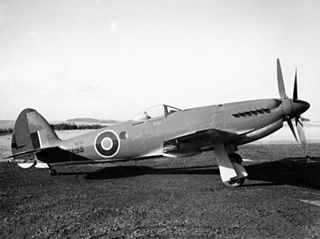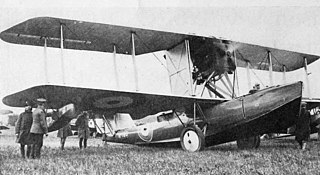Related Research Articles

The Curtiss A-8 was a low-wing monoplane ground-attack aircraft built by the United States company Curtiss Aeroplane and Motor Company, designed in response to a 1929 United States Army Air Corps requirement for an attack aircraft to replace the A-3 Falcon. The Model 59 "Shrike" was designated XA-8.

The Supermarine Seafang was a British Rolls-Royce Griffon–engined fighter aircraft designed by Supermarine to Air Ministry specification N.5/45. It was a further development of Supermarine's famous Spitfire and Spiteful aircraft, which by that point was a 10-year-old design following a rapid period of aviation development in history. It was outmoded by jet aircraft, and only 18 were built.

The Sukhoi Su-6 was a Soviet ground-attack aircraft developed during World War II. The mixed-power high-altitude interceptor Su-7 was based on the single-seat Su-6 prototype.

The Arado Ar 197 was a German World War II-era biplane, designed for naval operations for the never-completed German aircraft carrier Graf Zeppelin. Only a few prototypes were built; the project was abandoned in favour of the Messerschmitt Bf 109T and Me 155.
The Arado Ar 195 was a single-engine prototype carrier-based torpedo bomber, built by the German firm Arado for service on the German aircraft carrier Graf Zeppelin, during World War II.
The Nakajima Ki-19 was an unsuccessful attempt by Nakajima Aircraft Company to meet a 1935 requirement issued by the Japanese government for a modern bomber to replace the Mitsubishi Ki-1 heavy bomber.
The Armstrong Whitworth A.W.29 was a British bomber aircraft built by Armstrong Whitworth Aircraft.

The Caproni Ca.355 Tuffo was a low wing single-engine dive bomber, designed and built by the Italian Caproni company in 1941, which never proceeded beyond a single prototype. Derived from Ca.335 Mistral, the Ca.355 was proposed to equip the Regia Aeronautica, but it was found to offer little advantage over the German Junkers Ju 87 "Stuka" and the project was abandoned.

The Supermarine Sheldrake was a British amphibian biplane flying boat developed by Supermarine from the Supermarine Seagull with a revised hull. It was powered by a Napier Lion engine mounted between the wings driving a four-bladed propeller. Only one Sheldrake, serial number N180, was built.

The Breda A.14 was a prototype three-engined biplane, designed by Società Italiana Ernesto Breda as a night bomber in 1928. The aircraft was proposed to the Regia Aeronautica, but failed assessments, and was abandoned. The aircraft was designed to solve the flight problems experienced on the A.8. The A.14 was tested in 1928, powered by three 340 kW (450 hp) Alfa Romeo Jupiter engines. Although performance was improved, the Regia Aeronautica decided not to accept the A.14. To make up for the costs, it was suggested that a demilitarised version be sold to civilians, but a lack of civilian interest resulted in the abandonment of the project.
The Caproni Ca.350 was an Italian single-engined project for a two-seat fighter-bomber/reconnaissance aircraft of the 1930s. Designed by Cesare Pallavicino to meet a requirement of the Regia Aeronautica, it was an innovative and fast design, to have been powered by an Isotta Fraschini Zeta R.C.42, but no aircraft were built.

The Arado E.560 was a series of multi-engined Arado medium-range tactical bombers projected during the Second World War.
The Zeppelin Lindau C.I was a German single-engine two-seat biplane, designed by Claude Dornier and built by Zeppelin Lindau in World War II. Intended to investigate stressed-skin construction, it had an all-metal fuselage in which the Aluminium alloy skin was load bearing; the wings had aluminium alloy box spars but were fabric covered
The Zeppelin-Lindau CS.I was a German single-engined reconnaissance seaplane with a low-wing monoplane layout.

The Bréguet XI was a prototype French biplane bomber of the First World War.
The Caproni Ca.66 and Caproni Ca.67 were Italian night bomber aircraft designed to re-equip the post-World War I Regia Aeronautica.
The Caproni Ca.79 was an Italian light bomber produced in the mid-1920s.
The Caproni Ca.120 was a three-engine monoplane bomber built by Caproni in the 1930s.
The Caproni Ca.142 was a three-engined multirole aircraft built by Caproni in the mid-1930s.
The Heinkel HD 34 was a reconnaissance bomber built in Germany in the late 1920s.
References
- ↑ Forsyth, 2018. Dornier Do 335 (X-Planes Series). Osprey Publishing